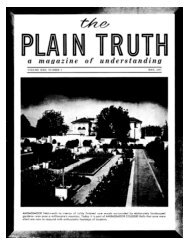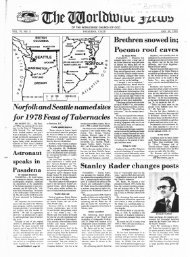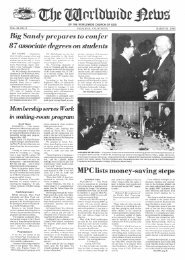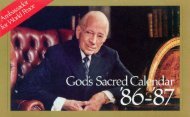The Biblical Basis of the Sacred Calendar Part One
The Biblical Basis of the Sacred Calendar Part One
The Biblical Basis of the Sacred Calendar Part One
You also want an ePaper? Increase the reach of your titles
YUMPU automatically turns print PDFs into web optimized ePapers that Google loves.
cycle. Thus <strong>the</strong> 19-year, Sabbatical and Jubilee Year cycles correlate with each o<strong>the</strong>r in a "full cycle" <strong>of</strong><br />
950 years. (<strong>One</strong> more Jubilee cycle would bring us to 1000 years: <strong>the</strong> length <strong>of</strong> <strong>the</strong> prophetic Millennium.<br />
This can hardly be a coincidence!) During one full cycle, 7 out <strong>of</strong> 19 Jubilees (about 37%) would be leap<br />
years, while 49 out <strong>of</strong> 135 Sabbatical Years (about 36%) would be leap years. Since <strong>the</strong>re is no biblical<br />
law or principle forbidding this from occurring, God evidently intended not to eliminate, but to minimize<br />
whatever hardship an extra-long Sabbatical or Jubilee Year would cause.<br />
If we assume that from Ezra's time onward, only <strong>the</strong> Sabbatical Years were observed (cf. Nehemiah<br />
10:31), <strong>the</strong>n leap years and Sabbatical Years would have coincided more <strong>of</strong>ten, causing greater hardship<br />
(in addition to that eventually imposed by <strong>the</strong> Romans). On <strong>the</strong> o<strong>the</strong>r hand, later Jewish sources suggest<br />
that <strong>the</strong> Juiblee Year was indeed observed so long as <strong>the</strong> Second Temple was standing (see footnote 26<br />
once more). Ei<strong>the</strong>r way, it is no surprise that many rabbis (after <strong>the</strong> fall <strong>of</strong> <strong>the</strong> Second Temple) concluded<br />
one should not intercalate on Sabbatical or post-Sabbatical Years. Even so, some recommended<br />
intercalation on <strong>the</strong> year preceding, some <strong>the</strong> year following <strong>the</strong> Land Sabbath, depending on whe<strong>the</strong>r<br />
<strong>the</strong>y believed importing "herbs" from "unclean" lands outside Israel was permitted (Sanhedrin 12a,<br />
Soncino edition, p. 53). <strong>The</strong> result? Confusion and an increasingly irregular sequence <strong>of</strong> leap years -- not<br />
increasing regularity as <strong>the</strong> Encyclopedia Judaica supposes ("<strong>Calendar</strong>", vol. 5, col. 49).<br />
Now we are ready to explain o<strong>the</strong>r uses <strong>of</strong> mo`ed in connection with <strong>the</strong> Festivals. We read in Leviticus<br />
23:4 (KJV): "<strong>The</strong>se are <strong>the</strong> feasts [mo`adim] <strong>of</strong> <strong>the</strong> LORD...which ye shall proclaim in <strong>the</strong>ir seasons<br />
[mo`adim]." <strong>The</strong> second usage <strong>of</strong> mo`adim refers to <strong>the</strong> appointed times as set by <strong>the</strong> lunar cycles against<br />
<strong>the</strong> solar seasons in a 19-year cycle (as implied by Genesis 1:14). <strong>The</strong> first usage refers by extension to<br />
<strong>the</strong> religious observances on specific days during <strong>the</strong>se "appointed times".27 But in <strong>the</strong> first usage,<br />
mo`adim does not mean exactly <strong>the</strong> same thing as in Genesis 1:14 (though this usage derives from that<br />
<strong>of</strong> Genesis 1:14).<br />
In Deuteronomy 16:6, mo`ed is translated "season" in <strong>the</strong> KJV. Here it refers to <strong>the</strong> anniversary <strong>of</strong> <strong>the</strong><br />
very night when Israel left Egypt: a night in <strong>the</strong> spring, when <strong>the</strong> moon is full (<strong>the</strong> 15th <strong>of</strong> Abib or Nisan). It<br />
does not refer to <strong>the</strong> solar "season" <strong>of</strong> spring as such. But <strong>the</strong> "passover" eaten on that night (and<br />
discussed in verses 3-7) was not <strong>the</strong> lamb mentioned in verse 2, but a bullock from <strong>the</strong> herd (same<br />
verse). This o<strong>the</strong>r "passover" was later called Chagigah ("Festivity") in <strong>the</strong> Second Temple service.28<br />
Once this is understood, <strong>the</strong> "Nisan 14/15 Passover question" may be resolved.<br />
* "Days" (yamim, <strong>the</strong> plural <strong>of</strong> yom) are determined by <strong>the</strong> apparent motions <strong>of</strong> <strong>the</strong> sun in <strong>the</strong> sky (as<br />
caused by <strong>the</strong> earth's rotation). As we will see, days may be reckoned noon-to-noon (for astronomical<br />
purposes) or sunset-to-sunset (for calendrical and religious purposes).<br />
We find in Leviticus 23:32 and o<strong>the</strong>r verses that <strong>the</strong> calendar day is measured sunset-to-sunset. What is<br />
not commonly recognized is that <strong>the</strong> language <strong>of</strong> Genesis 1 implies <strong>the</strong> existence <strong>of</strong> a round earth, with<br />
<strong>the</strong> narrator recounting events as <strong>the</strong>y appeared to occur at <strong>the</strong> "prime meridian" <strong>of</strong> <strong>the</strong> earth. "And <strong>the</strong><br />
evening and <strong>the</strong> morning were..." literally means "and it came to be evening, and it came to be<br />
morning...", implying a sunrise-to-sunrise local day. (<strong>The</strong> implications <strong>of</strong> this will be spelled out more fully<br />
below.)<br />
* "Years" (shanim, plural <strong>of</strong> shanah) are determined by <strong>the</strong> apparent motion <strong>of</strong> <strong>the</strong> sun against <strong>the</strong> stars<br />
(thanks to <strong>the</strong> earth's revolution around <strong>the</strong> sun), which occur even as <strong>the</strong> sun makes its daily motion<br />
through <strong>the</strong> sky.29 <strong>The</strong>se "years" may be measured differently: against a particular star (<strong>the</strong> sidereal<br />
year), from noon to noon (<strong>the</strong> solar year), relative to <strong>the</strong> spring equinox (<strong>the</strong> tropical year), relative to <strong>the</strong><br />
fall equinox (<strong>the</strong> agricultural year, as observed in <strong>the</strong> land <strong>of</strong> Israel), and so on. Since <strong>the</strong> sacred calendar<br />
and its Festivals are so closely linked to <strong>the</strong> harvest seasons, it is closely connected with <strong>the</strong> tropical and<br />
agricultural years as well as <strong>the</strong> solar year.<br />
Thus Genesis 1:14 describes <strong>the</strong> astronomical hierarchy on which <strong>the</strong> sacred calendar is to be based.<br />
<strong>One</strong> o<strong>the</strong>r factor must be considered: where <strong>the</strong> calendar day begins on <strong>the</strong> earth's surface, as implied by
















